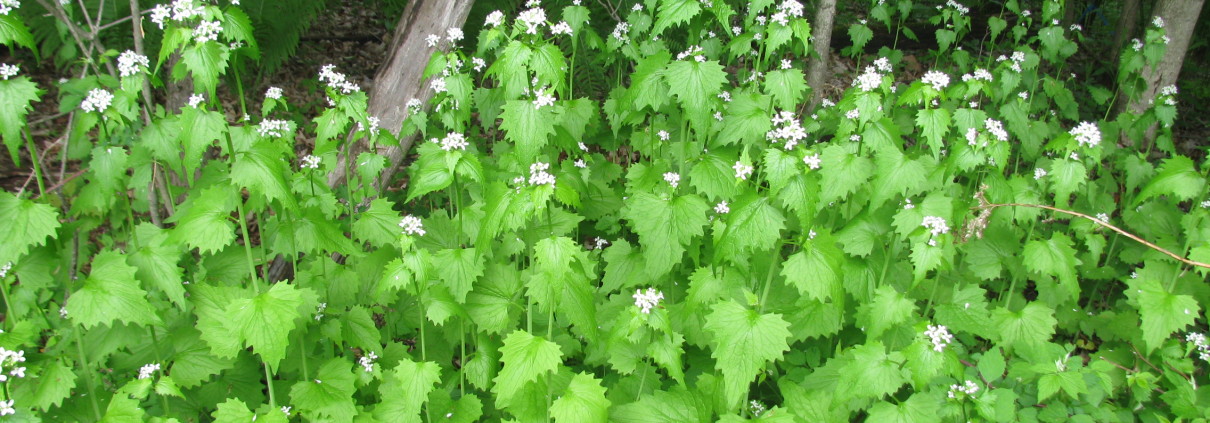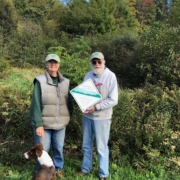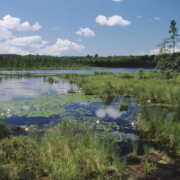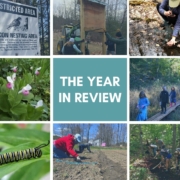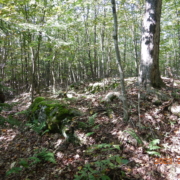Declining Biodiversity in Vermont and New Hampshire Forests, Part III: Space Invaders
If you’re a gardener, you may have heard some buzz about the importance of native plants over the past few years — but do you know why it’s important to plant and protect these species, or how invasive plant species can harm our ecosystems?
On May 22, Upper Valley residents gathered at the Howe Library in Hanover to learn those answers and more in a talk titled “Space Invaders,” featuring speakers including Steve Mortillo, Natural Resources Program Lead, Saint Gaudens National Historical Park and Marsh-Billings-Rockefeller National Historical Park; Markus Bradley, a partner with Redstart Natural Resource Management; Li Shen from the Thetford Conservation Commission; Lynnwood Andrews, Norwich Conservation Commission, Barbara McIlroy of the Hanover Conservation Commission, as well as slides from Pattie Fried of the Mascoma Lakeside Park Restoration Program in Enfield, who was unable to attend the event in person. Sarah Riley, chair of the Lebanon Conservation Commission, moderated the panel.
The third installment in a series of events organized by local organizations, including the UVLT, this talk explored how invasive plant species are contributing to declining biodiversity in Vermont and New Hampshire forests. Speakers delved deep into the risks that invasive plants pose to our local environment and laid out strategies to take action.
Why Managing Invasive Plants Matters
Managing the spread of invasive plants isn’t an aesthetic choice — it’s essential to preserving biodiversity. That’s because in many cases, invasive species hijack the nutrients and sun access that native plants need to thrive, disrupting everything from nutrient cycling to water circulation and negatively impacting the health of wildlife populations that depend on native species for forage.
“Invasive species don’t support as much life as native trees and shrubs do,” said Mortillo. “Over time, they can win out in a forest ecosystem and lead to total forest collapse, where you have nothing but shrubs. That’s the worst-case scenario, but there are instances of this happening here on the East Coast.”
In some cases, invasive species can even prove deadly to native plants and wildlife. For example, as McIlroy explained, garlic
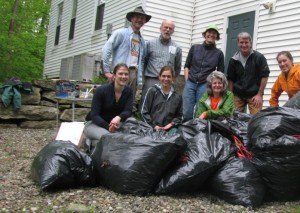
UVLT volunteers with bags of garlic mustard pulled from the Mink Brook Nature Preserve.
mustard — which is highly prevalent in the Upper Valley and spreads remarkably quickly — produces a compound that decimates mycorrhizal fungi in the soil that are essential to plant health. In fact, soil that has been overtaken by garlic mustard is nearly as hostile to other plants as sterilized soil.
So why are invasive species so prevalent?
Part of the problem, explained Bradley, is that harvesting wood for human use inevitably shifts the ecosystem in the Northeast toward invasive species. “Every American uses 1.75 pounds of wood products a day,” he explained. “Even your dog uses wood products.”
Once invasive species are introduced to an area, the “invasion curve” takes hold — essentially, as these species are allowed to spread, it becomes exponentially more difficult and expensive to control them. This is exacerbated by rising deer populations, which prefer to forage native plants and, in doing so, provide more space for invasive species to spread.
Unfortunately, our area is already far up the curve. In addition to garlic mustard, common invasive species in our area include black swallow-wort, buckthorn, euonymus, wild chervil, bedstraw, water forget-me-knots, and many more. Some are easily mistaken for native species — for example, invasive Asiatic bittersweet looks very similar to American bittersweet, and invasive varieties of honeysuckle closely resemble native varieties.
Many of these species are most likely to thrive in areas where there is nearly always sunlight at ground level, said Bradley, like white pine stands and wetlands, as well as areas alongside powerlines and road edges.
Not sure if you are looking at a native plant or a lookalike invader? Morillo recommended using apps like Seek to help you identify vegetation.
Lessons from Local Resource Managers
Morillo and Bradley, who have both worked to eradicate large-scale infestations, agreed that to keep these plants at bay, regular surveillance and multiple approaches to invasive species management are essential.
As Morillo shared, when the Mash-Billings-Rockefeller resource management team took oversight over Saint Gaudens in 2016, their first step was to bring in a forester to assess all invasive species at Saint Gaudens and identify their relative impacts in different forest stands. While some areas of the park were in reasonably good shape, others were heavily infested. However, with limited resources, the resource management team knew that they couldn’t address the entire property in one year.
Instead, in the early years of the project, the team prioritized maintaining the stands that were already in good shape, primarily using mechanical means. Over time, they expanded their efforts to the more heavily invaded areas while continuing to maintain the areas the areas that were least affected. They have also been able to access grant funding and additional resources through the National Park Service.
Since the size and scale of established shrubs — and the persistence of certain species, like black swallowwort — make it impossible to rely on mechanical removal alone, Mortillo’s team uses the “cut surface” approach to managing invasive plants. This involves cutting back shrubs heavily and then applying a glyphosate-based herbicide using a specialized applicator.
Bradley also uses glyphosate (the main ingredient in Roundup) to help control invasive species and shared that he prefers to use the versions designed for use on weeds found in ponds, which are less toxic to fish and amphibians.
“No one likes to use an herbicide, but the end result was native regeneration — and that’s why we took that approach,” said Mortillo. “We know we wouldn’t be able to get that result in certain areas of the park without cut surface herbicide application.”
He said this approach has had encouraging results at Saint Gaudens in the past several years. Between 2018 and 2022, the team treated 16 acres of heavily infested forest, and they have seen that invasive species remain at bay and the forest begins to regrow two to three years after the initial herbicide applications. His team’s goal moving forward is to regenerate native plants and keep invasive species under control, which they hope will allow them to significantly reduce or eliminate herbicide use.
“Over time, this will hopefully lead to a more diverse ecosystem, one that is more resilient to climate change and more supportive of life,” he said.
How Individuals and Towns Can Help
As Bradley explained, containing invasive species requires cooperation from all landowners — those with small pieces of land as well as large commercial operations. While ending the harvest and production of wood products isn’t the answer, he says, landowners and foresters need to take responsibility for doing so in a sustainable, responsible manner.
“If you’re going to disturb your forest, be responsible and understand that in this day and age, you need to take invasive plants seriously,” he urged.
Even if you don’t control a large area of land, there’s plenty you can do to help. Mortillo noted that help from interns and volunteers was critical to the success at Saint Gaudens, and there are plenty of opportunities to help out in Upper Valley towns.
As Shen, Andrews, and McIlroy shared, buy-in from local residents is essential to helping conservation committees, who typically rely on grant funding and limited town budget allocations and always need volunteers.
In Hanover, for instance, the town has organized a townwide garlic mustard pull and conducted an information campaign, including extensive signage at trailheads, explaining what garlic mustard is, why it’s a problem, and how to identify it and notify the town.
While the problem of invasive plant species is unlikely to go away anytime soon, by working together to educate local residents and share best practices for land management, we can do our part to ensure the longevity of our native plant species.

